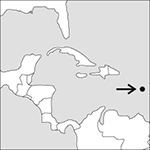
Capital:
Roseau
Area:
751 sq km (290 sq miles)
Population:
73,286 (2012 est)
Currency:
1 East Caribbean dollar = 100 cents
Religions:
Roman Catholic 61.4%; Protestant 20.6%; other Christian 8.9%
Ethnic Groups:
Black 86.8%; mixed 8.9%; Amerindian 2.9%
Languages:
English (official); French creole
International Organizations:
UN; OAS; CARICOM; Commonwealth; WTO; Non‐Aligned Movement
An island country, the second largest of the Windward group of the Caribbean Islands.
Physical
The loftiest island in the region, it has a mountainous ridge rising to Morne Diablotin, at 1447 m (4747 feet). Dominica is volcanic origin and has beautiful scenery, with forests, waterfalls, craters, and springs. Only the coastline is cultivable on any scale.
Economy
Dominica’s economy was formerly dependent on agriculture, with bananas the leading crop, but tourism is increasingly important and the government hopes to develop an offshore financial sector. Bananas are still the principal export, followed by soap, bay oil, and fruit and vegetables.
History
When Europeans first arrived Dominica was inhabited by Carib Indians, who had driven out the earlier inhabitants, the Arawaks. During the 18th century the French and British fought with each other, and with the Caribs, for control of the island. Britain was in possession of the island in 1805, when the French made their last attempt to capture Dominica but were driven out by the British. In 1958 Dominica joined the West Indian Federation and it became an autonomous British Associated State in 1967. It gained full independence in 1978.
Dominica was devastated by hurricanes in 1979 and 1980, and there were two attempted coups in 1981. The Dominican Freedom Party (DFP), under Dame Eugenia Charles (1919–2005), governed the country from 1980 until 1995, when the United Workers’ Party (DUWP) won elections. Since 2000 the Dominica Labour Party (DLP) has held power, in coalition until 2005 and alone thereafter.
- quantum Hall effect
- quantum Hall ferromagnet
- quantum heterostructure
- quantum hypothesis((in neurophysiology))
- quantum information theory
- quantum interferometry
- quantum jump
- quantum key distribution
- quantum logic
- quantum mechanics
- quantum metrology
- quantum number
- quantum numbers
- quantum optics
- quantum phase transition
- quantum resistance metrology
- quantum simulation
- quantum spin liquid
- quantum state
- quantum statistics
- quantum teleportation
- quantum theory
- quantum theory of radiation
- quantum transient
- quantum turbulence